Student's Weaknesses Analysis: Identifying Areas for Improvement
VerifiedAdded on 2020/03/16
|5
|1045
|46
Essay
AI Summary
This essay delves into a student's self-assessment of their personal and professional weaknesses, specifically focusing on experiences as a secretary in a law firm. The student identifies a short temper and favoritism as key weaknesses, leading to negative consequences. The essay utilizes the Johari Window model to understand self-perception and how others view the student. It then outlines a SMART goal-setting strategy to address these weaknesses, emphasizing specific, measurable, attainable, relevant, and time-based goals for improvement. The conclusion highlights the importance of understanding different personalities in a professional setting and the influence of situational, environmental, and hereditary factors. The student also mentions alternative methods like SWOT and the Ability Model of Emotional Intelligence for weakness identification. The essay includes a bibliography of relevant sources.
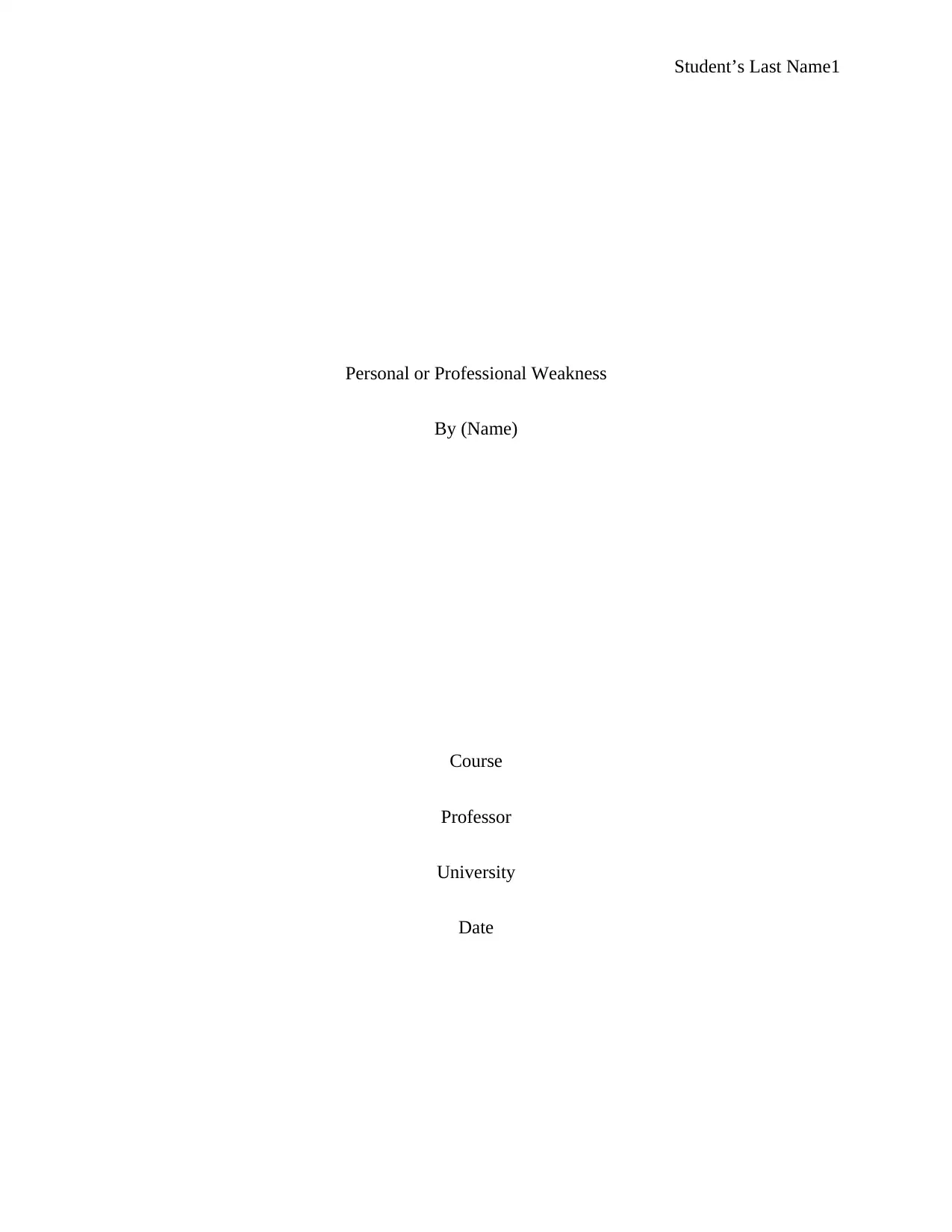
Student’s Last Name1
Personal or Professional Weakness
By (Name)
Course
Professor
University
Date
Personal or Professional Weakness
By (Name)
Course
Professor
University
Date
Paraphrase This Document
Need a fresh take? Get an instant paraphrase of this document with our AI Paraphraser
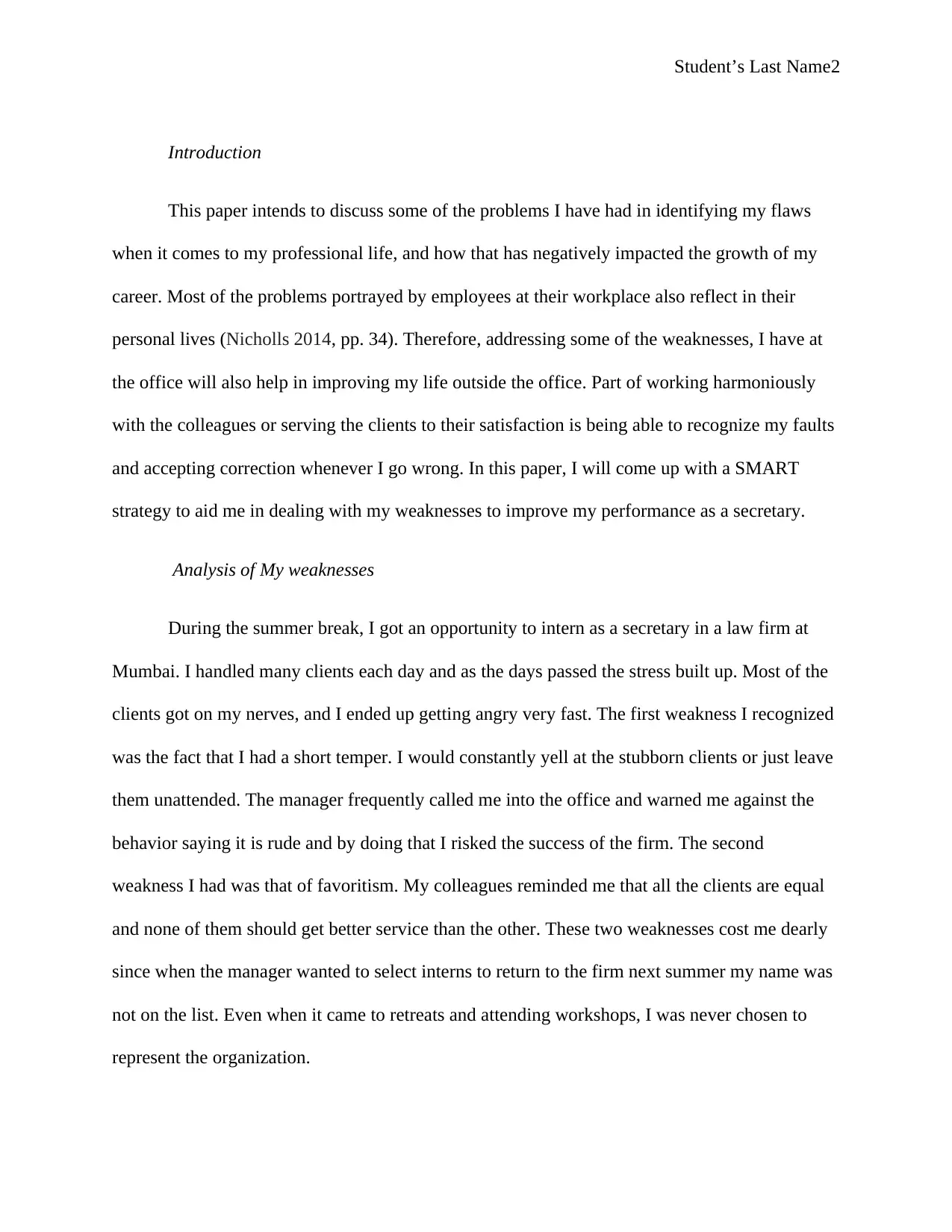
Student’s Last Name2
Introduction
This paper intends to discuss some of the problems I have had in identifying my flaws
when it comes to my professional life, and how that has negatively impacted the growth of my
career. Most of the problems portrayed by employees at their workplace also reflect in their
personal lives (Nicholls 2014, pp. 34). Therefore, addressing some of the weaknesses, I have at
the office will also help in improving my life outside the office. Part of working harmoniously
with the colleagues or serving the clients to their satisfaction is being able to recognize my faults
and accepting correction whenever I go wrong. In this paper, I will come up with a SMART
strategy to aid me in dealing with my weaknesses to improve my performance as a secretary.
Analysis of My weaknesses
During the summer break, I got an opportunity to intern as a secretary in a law firm at
Mumbai. I handled many clients each day and as the days passed the stress built up. Most of the
clients got on my nerves, and I ended up getting angry very fast. The first weakness I recognized
was the fact that I had a short temper. I would constantly yell at the stubborn clients or just leave
them unattended. The manager frequently called me into the office and warned me against the
behavior saying it is rude and by doing that I risked the success of the firm. The second
weakness I had was that of favoritism. My colleagues reminded me that all the clients are equal
and none of them should get better service than the other. These two weaknesses cost me dearly
since when the manager wanted to select interns to return to the firm next summer my name was
not on the list. Even when it came to retreats and attending workshops, I was never chosen to
represent the organization.
Introduction
This paper intends to discuss some of the problems I have had in identifying my flaws
when it comes to my professional life, and how that has negatively impacted the growth of my
career. Most of the problems portrayed by employees at their workplace also reflect in their
personal lives (Nicholls 2014, pp. 34). Therefore, addressing some of the weaknesses, I have at
the office will also help in improving my life outside the office. Part of working harmoniously
with the colleagues or serving the clients to their satisfaction is being able to recognize my faults
and accepting correction whenever I go wrong. In this paper, I will come up with a SMART
strategy to aid me in dealing with my weaknesses to improve my performance as a secretary.
Analysis of My weaknesses
During the summer break, I got an opportunity to intern as a secretary in a law firm at
Mumbai. I handled many clients each day and as the days passed the stress built up. Most of the
clients got on my nerves, and I ended up getting angry very fast. The first weakness I recognized
was the fact that I had a short temper. I would constantly yell at the stubborn clients or just leave
them unattended. The manager frequently called me into the office and warned me against the
behavior saying it is rude and by doing that I risked the success of the firm. The second
weakness I had was that of favoritism. My colleagues reminded me that all the clients are equal
and none of them should get better service than the other. These two weaknesses cost me dearly
since when the manager wanted to select interns to return to the firm next summer my name was
not on the list. Even when it came to retreats and attending workshops, I was never chosen to
represent the organization.
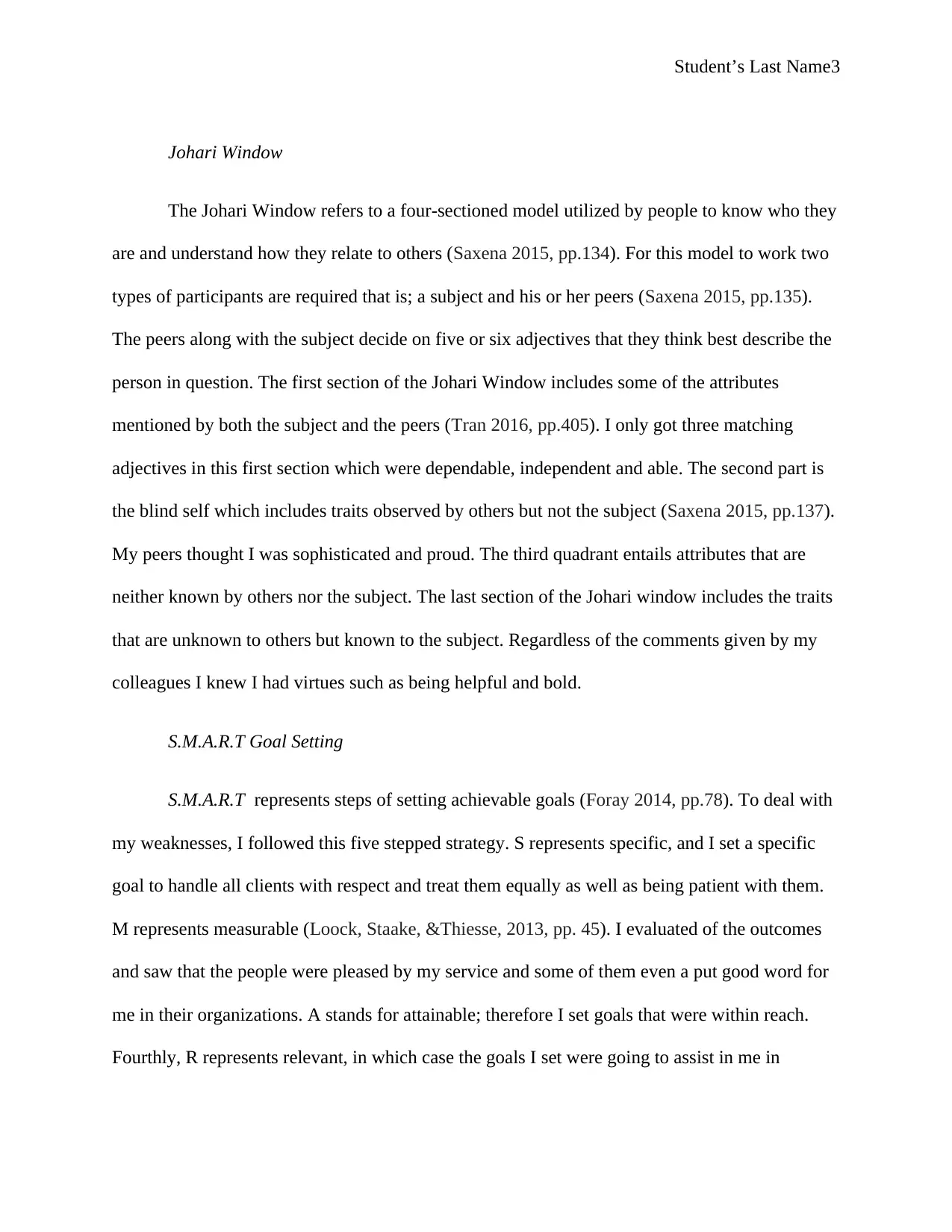
Student’s Last Name3
Johari Window
The Johari Window refers to a four-sectioned model utilized by people to know who they
are and understand how they relate to others (Saxena 2015, pp.134). For this model to work two
types of participants are required that is; a subject and his or her peers (Saxena 2015, pp.135).
The peers along with the subject decide on five or six adjectives that they think best describe the
person in question. The first section of the Johari Window includes some of the attributes
mentioned by both the subject and the peers (Tran 2016, pp.405). I only got three matching
adjectives in this first section which were dependable, independent and able. The second part is
the blind self which includes traits observed by others but not the subject (Saxena 2015, pp.137).
My peers thought I was sophisticated and proud. The third quadrant entails attributes that are
neither known by others nor the subject. The last section of the Johari window includes the traits
that are unknown to others but known to the subject. Regardless of the comments given by my
colleagues I knew I had virtues such as being helpful and bold.
S.M.A.R.T Goal Setting
S.M.A.R.T represents steps of setting achievable goals (Foray 2014, pp.78). To deal with
my weaknesses, I followed this five stepped strategy. S represents specific, and I set a specific
goal to handle all clients with respect and treat them equally as well as being patient with them.
M represents measurable (Loock, Staake, &Thiesse, 2013, pp. 45). I evaluated of the outcomes
and saw that the people were pleased by my service and some of them even a put good word for
me in their organizations. A stands for attainable; therefore I set goals that were within reach.
Fourthly, R represents relevant, in which case the goals I set were going to assist in me in
Johari Window
The Johari Window refers to a four-sectioned model utilized by people to know who they
are and understand how they relate to others (Saxena 2015, pp.134). For this model to work two
types of participants are required that is; a subject and his or her peers (Saxena 2015, pp.135).
The peers along with the subject decide on five or six adjectives that they think best describe the
person in question. The first section of the Johari Window includes some of the attributes
mentioned by both the subject and the peers (Tran 2016, pp.405). I only got three matching
adjectives in this first section which were dependable, independent and able. The second part is
the blind self which includes traits observed by others but not the subject (Saxena 2015, pp.137).
My peers thought I was sophisticated and proud. The third quadrant entails attributes that are
neither known by others nor the subject. The last section of the Johari window includes the traits
that are unknown to others but known to the subject. Regardless of the comments given by my
colleagues I knew I had virtues such as being helpful and bold.
S.M.A.R.T Goal Setting
S.M.A.R.T represents steps of setting achievable goals (Foray 2014, pp.78). To deal with
my weaknesses, I followed this five stepped strategy. S represents specific, and I set a specific
goal to handle all clients with respect and treat them equally as well as being patient with them.
M represents measurable (Loock, Staake, &Thiesse, 2013, pp. 45). I evaluated of the outcomes
and saw that the people were pleased by my service and some of them even a put good word for
me in their organizations. A stands for attainable; therefore I set goals that were within reach.
Fourthly, R represents relevant, in which case the goals I set were going to assist in me in
⊘ This is a preview!⊘
Do you want full access?
Subscribe today to unlock all pages.

Trusted by 1+ million students worldwide
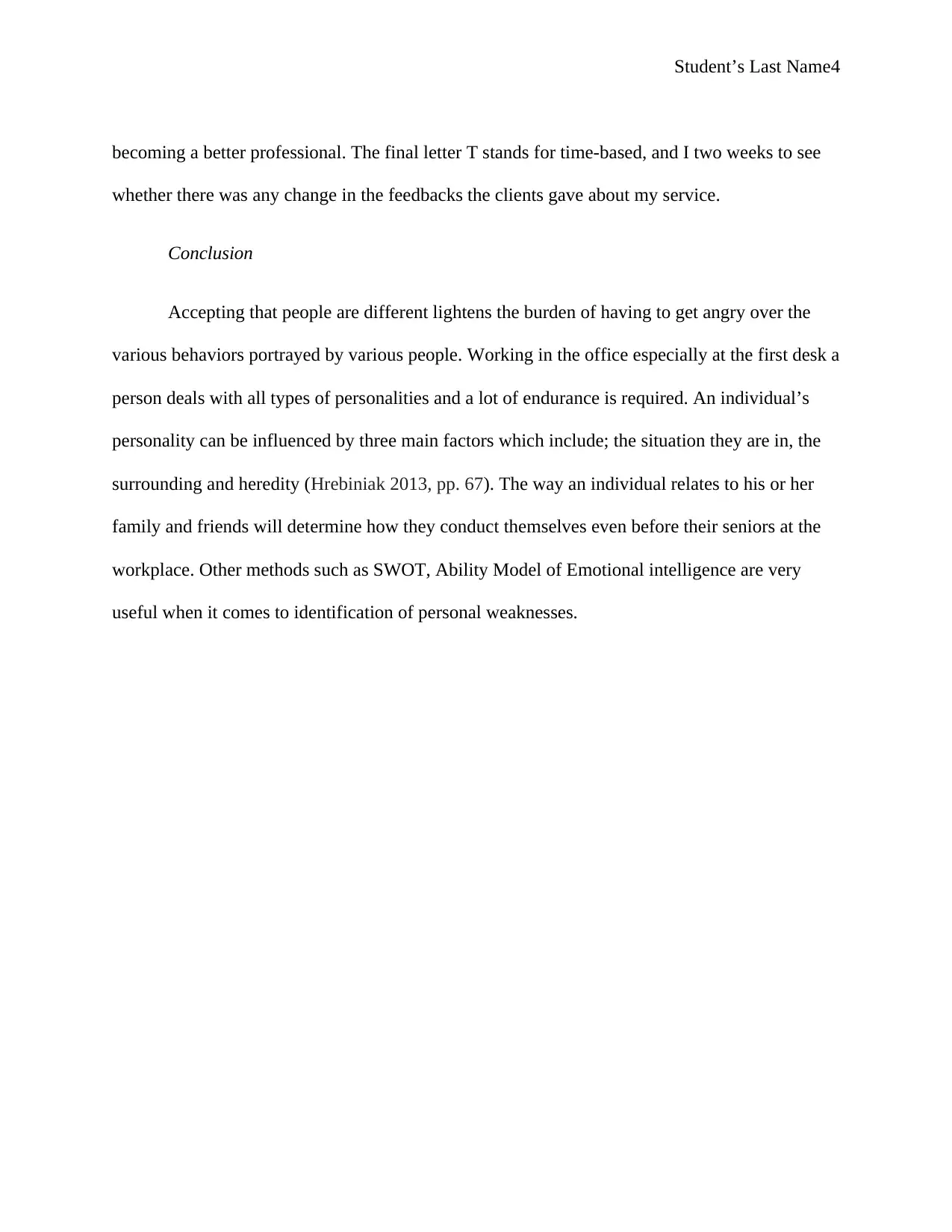
Student’s Last Name4
becoming a better professional. The final letter T stands for time-based, and I two weeks to see
whether there was any change in the feedbacks the clients gave about my service.
Conclusion
Accepting that people are different lightens the burden of having to get angry over the
various behaviors portrayed by various people. Working in the office especially at the first desk a
person deals with all types of personalities and a lot of endurance is required. An individual’s
personality can be influenced by three main factors which include; the situation they are in, the
surrounding and heredity (Hrebiniak 2013, pp. 67). The way an individual relates to his or her
family and friends will determine how they conduct themselves even before their seniors at the
workplace. Other methods such as SWOT, Ability Model of Emotional intelligence are very
useful when it comes to identification of personal weaknesses.
becoming a better professional. The final letter T stands for time-based, and I two weeks to see
whether there was any change in the feedbacks the clients gave about my service.
Conclusion
Accepting that people are different lightens the burden of having to get angry over the
various behaviors portrayed by various people. Working in the office especially at the first desk a
person deals with all types of personalities and a lot of endurance is required. An individual’s
personality can be influenced by three main factors which include; the situation they are in, the
surrounding and heredity (Hrebiniak 2013, pp. 67). The way an individual relates to his or her
family and friends will determine how they conduct themselves even before their seniors at the
workplace. Other methods such as SWOT, Ability Model of Emotional intelligence are very
useful when it comes to identification of personal weaknesses.
Paraphrase This Document
Need a fresh take? Get an instant paraphrase of this document with our AI Paraphraser
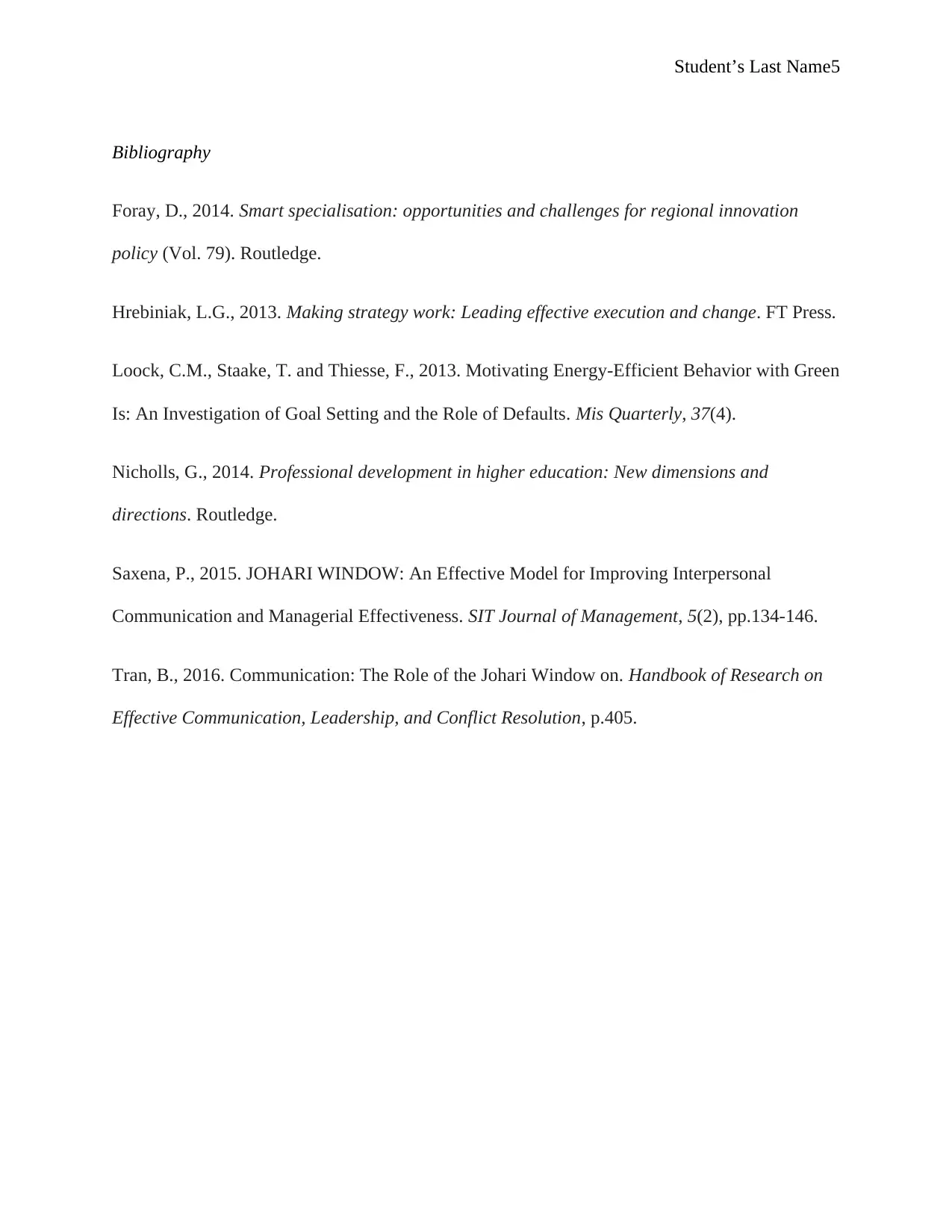
Student’s Last Name5
Bibliography
Foray, D., 2014. Smart specialisation: opportunities and challenges for regional innovation
policy (Vol. 79). Routledge.
Hrebiniak, L.G., 2013. Making strategy work: Leading effective execution and change. FT Press.
Loock, C.M., Staake, T. and Thiesse, F., 2013. Motivating Energy-Efficient Behavior with Green
Is: An Investigation of Goal Setting and the Role of Defaults. Mis Quarterly, 37(4).
Nicholls, G., 2014. Professional development in higher education: New dimensions and
directions. Routledge.
Saxena, P., 2015. JOHARI WINDOW: An Effective Model for Improving Interpersonal
Communication and Managerial Effectiveness. SIT Journal of Management, 5(2), pp.134-146.
Tran, B., 2016. Communication: The Role of the Johari Window on. Handbook of Research on
Effective Communication, Leadership, and Conflict Resolution, p.405.
Bibliography
Foray, D., 2014. Smart specialisation: opportunities and challenges for regional innovation
policy (Vol. 79). Routledge.
Hrebiniak, L.G., 2013. Making strategy work: Leading effective execution and change. FT Press.
Loock, C.M., Staake, T. and Thiesse, F., 2013. Motivating Energy-Efficient Behavior with Green
Is: An Investigation of Goal Setting and the Role of Defaults. Mis Quarterly, 37(4).
Nicholls, G., 2014. Professional development in higher education: New dimensions and
directions. Routledge.
Saxena, P., 2015. JOHARI WINDOW: An Effective Model for Improving Interpersonal
Communication and Managerial Effectiveness. SIT Journal of Management, 5(2), pp.134-146.
Tran, B., 2016. Communication: The Role of the Johari Window on. Handbook of Research on
Effective Communication, Leadership, and Conflict Resolution, p.405.
1 out of 5
Related Documents
Your All-in-One AI-Powered Toolkit for Academic Success.
+13062052269
info@desklib.com
Available 24*7 on WhatsApp / Email
![[object Object]](/_next/static/media/star-bottom.7253800d.svg)
Unlock your academic potential
Copyright © 2020–2025 A2Z Services. All Rights Reserved. Developed and managed by ZUCOL.




